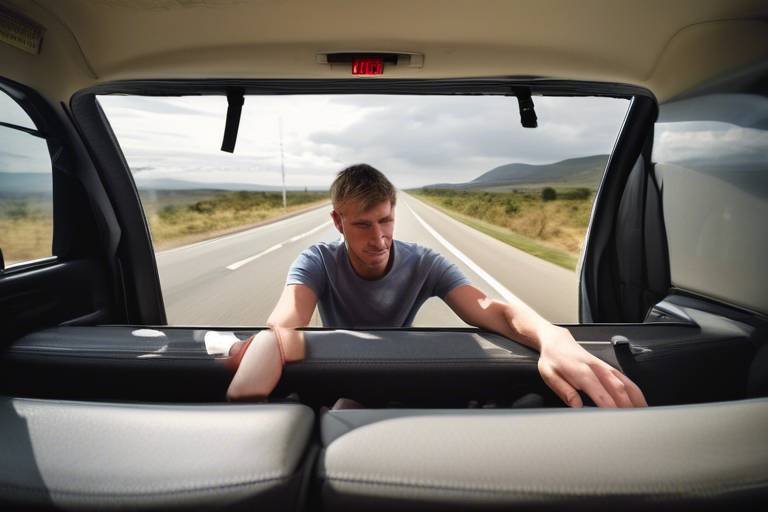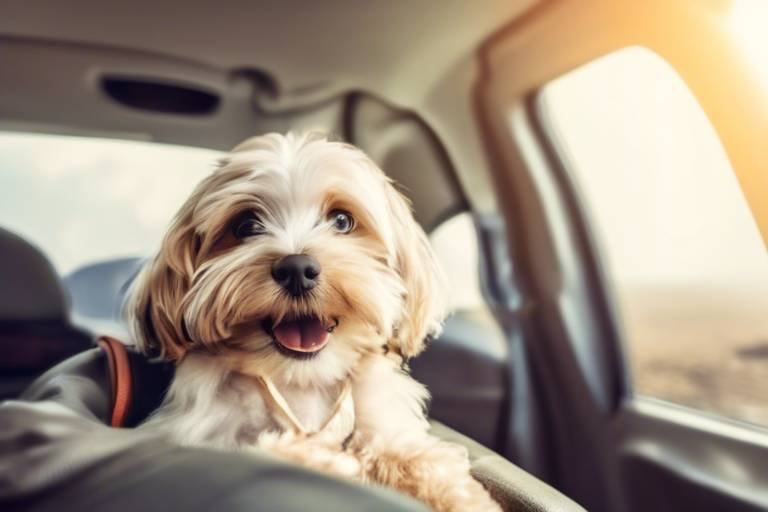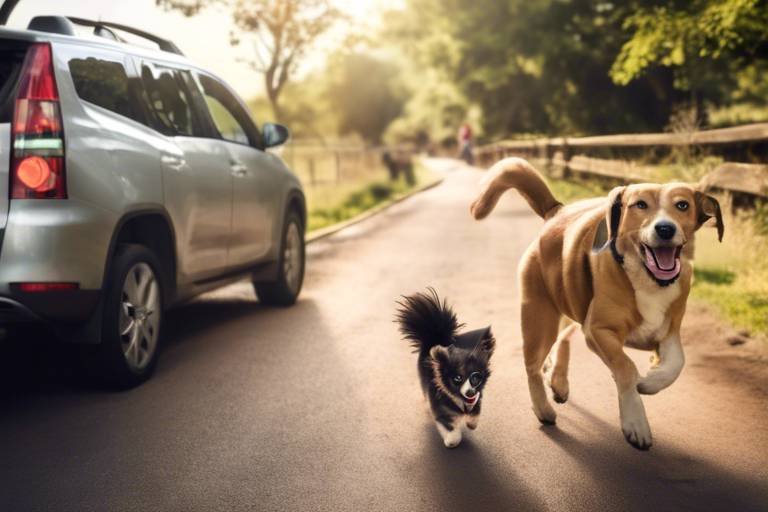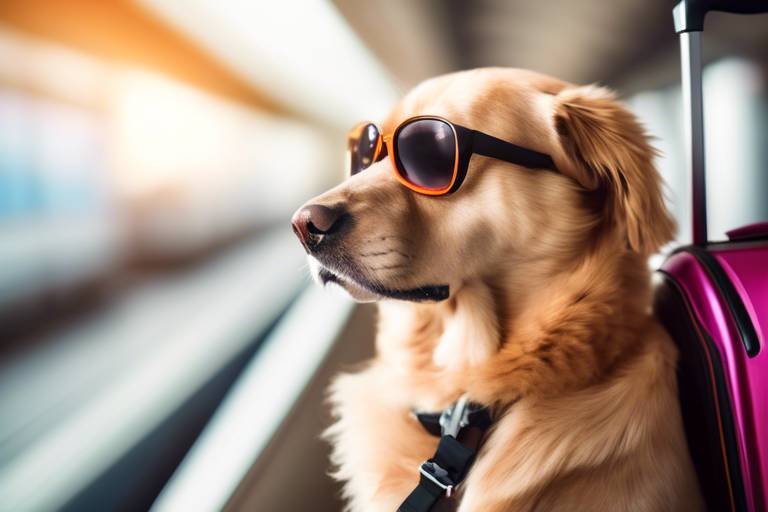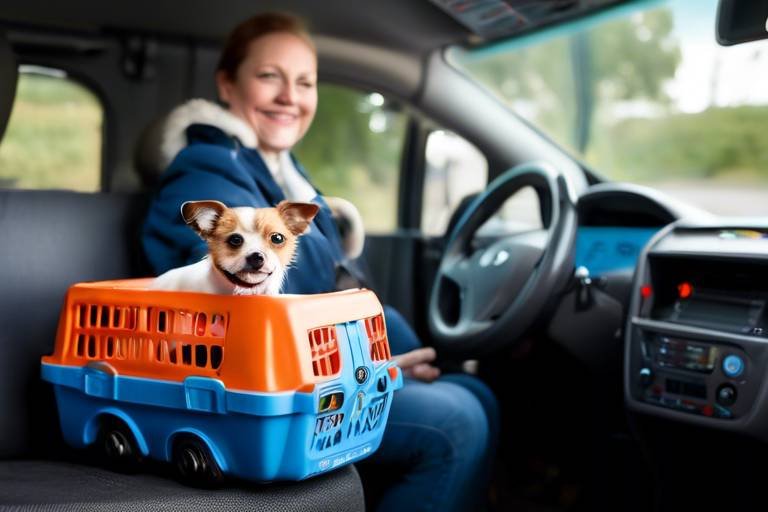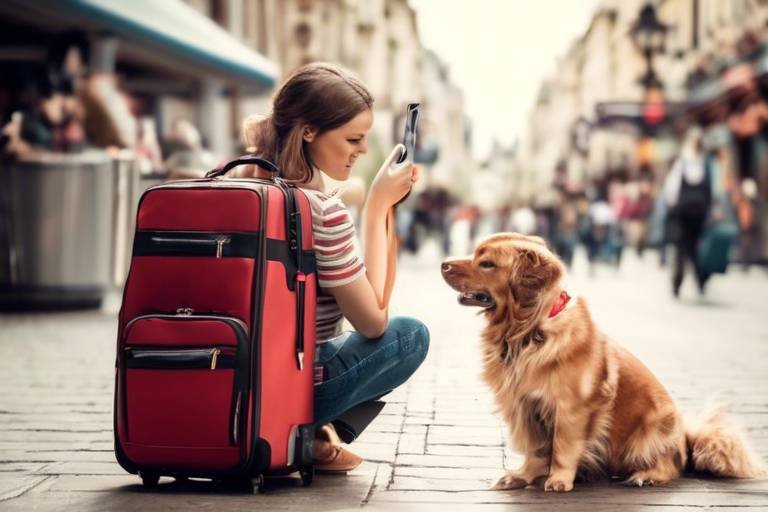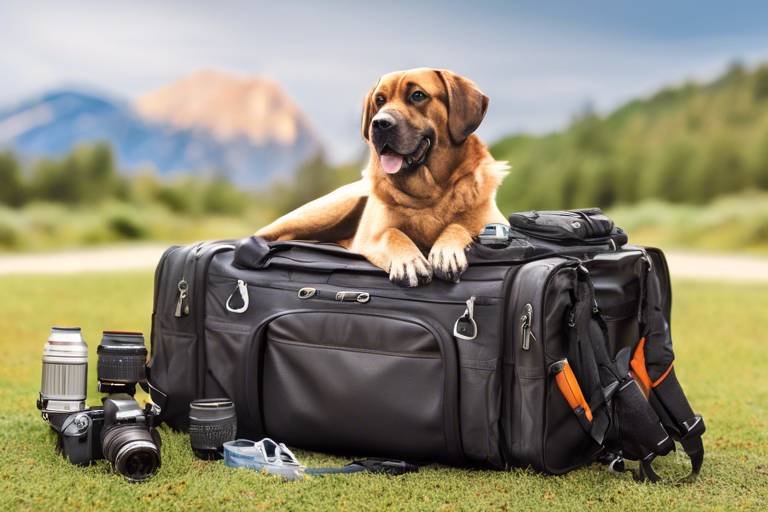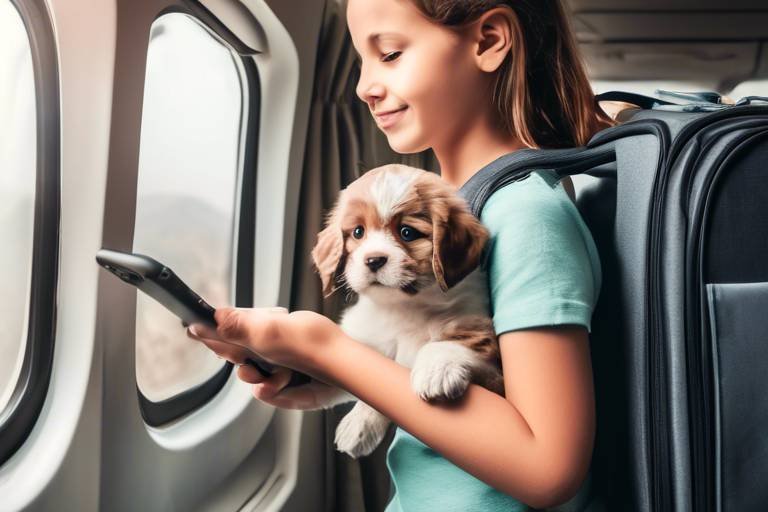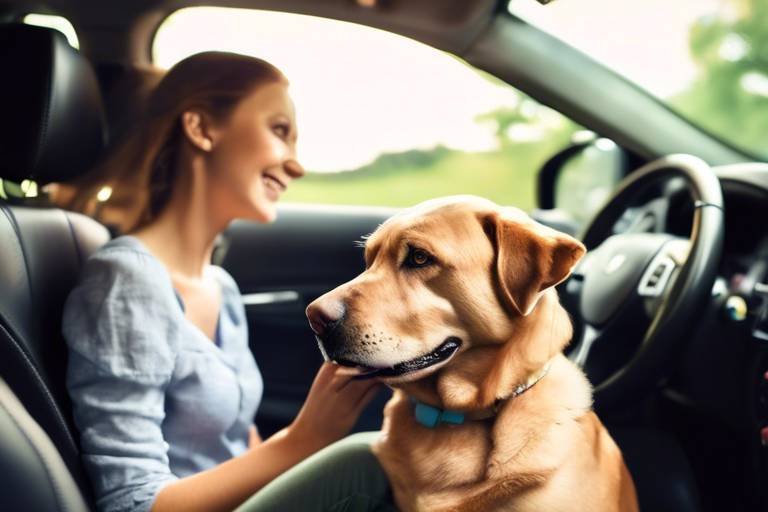Traveling with Pets - The Impact of Different Transportation Modes
Traveling with your furry friends can be one of the most rewarding experiences, but it also comes with its own set of challenges. Whether you’re planning a weekend getaway or a cross-country adventure, understanding how different transportation modes affect your pet is crucial. Each mode of travel—be it air, car, train, or bus—has its own unique set of benefits and drawbacks. By knowing what to expect, you can ensure a safe and enjoyable journey for both you and your beloved pet.
Imagine the excitement of hitting the road with your dog’s head sticking out of the window, ears flapping in the wind, or the thrill of watching your cat explore a new hotel room. However, the reality can sometimes be a bit more complicated. For instance, air travel may involve strict airline policies and cabin conditions that can be stressful for your pet. On the other hand, road trips can lead to endless bathroom breaks and hydration needs, especially during long drives. So, how do you navigate these waters? That’s where this article comes in!
In this article, we will dive deep into the ins and outs of traveling with pets across various transportation modes. You’ll learn about the specific challenges and benefits of each method, as well as tips and tricks to ensure your pet’s comfort and safety. Whether you’re a seasoned traveler or a first-timer, there’s something here for everyone. So buckle up, and let’s embark on this journey together!

Air Travel with Pets
Air travel presents unique challenges for pet owners, and understanding these challenges is crucial for ensuring a smooth journey for both you and your furry companion. First and foremost, each airline has its own policies regarding pet travel, which can vary significantly. Some airlines allow pets in the cabin, while others may require them to be transported in the cargo hold. This can be a source of anxiety for many pet owners, as the thought of their beloved pet being separated from them can be daunting.
When considering air travel, it’s essential to check the specific airline’s guidelines well in advance. This includes understanding the size and weight restrictions for pets traveling in the cabin, as well as any additional fees that may apply. For instance, some airlines may charge a fee for cabin pets, while others might include it in your ticket price. Additionally, it's advisable to book your flight early, as airlines often have a limited number of spots available for pets in the cabin.
Another critical factor to consider is the cabin conditions during the flight. Airplanes can become quite cramped, and the noise and unfamiliar surroundings can be stressful for pets. To help mitigate this stress, consider bringing along a familiar blanket or toy that smells like home. This small gesture can provide comfort and ease anxiety during the flight.
Moreover, it’s important to prepare your pet for the experience of flying. Start by acclimatizing them to their travel crate or carrier well before the trip. This can help them feel more comfortable and secure when the time comes to travel. Remember, the crate should be well-ventilated, spacious enough for your pet to stand, turn around, and lie down comfortably. Additionally, ensure that it is properly labeled with your contact information, as well as any relevant medical information.
Finally, consider the stress of flying on your pet. Some pets may experience anxiety or fear during air travel. If you suspect your pet might be one of them, consult your veterinarian about potential calming solutions. There are various options available, from natural remedies to prescribed medications, that can help your pet relax during the flight.
In summary, while air travel can be a convenient way to reach your destination, it requires careful planning and consideration. By understanding the airline’s policies, preparing your pet adequately, and taking steps to minimize stress, you can ensure that both you and your furry friend have a safer, more enjoyable journey.
- Can I take my pet in the cabin with me? - Many airlines allow small pets to travel in the cabin, but there are size and weight restrictions.
- What should I do if my pet has anxiety about flying? - Consult your veterinarian for calming solutions, including medications or natural remedies.
- How do I prepare my pet for air travel? - Acclimatize them to their carrier, label it with your information, and bring familiar items for comfort.
- Are there extra fees for traveling with pets? - Yes, most airlines charge a fee for pets traveling in the cabin or cargo.
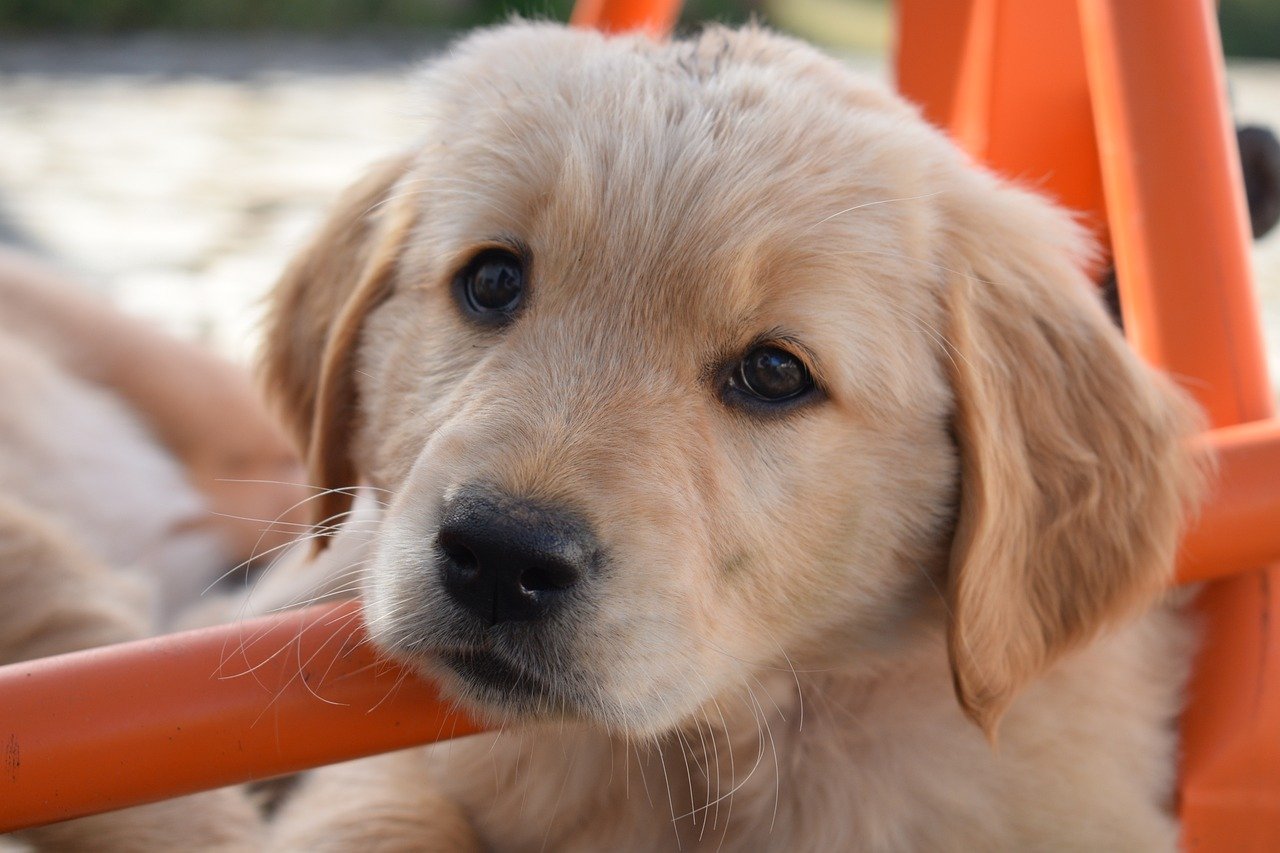
Traveling by Car
Road trips can be one of the most enjoyable experiences for both you and your furry friend. Imagine the wind in your hair, the open road ahead, and your pet happily enjoying the ride next to you. However, this blissful image doesn't come without its challenges. Proper planning and preparation are essential to ensure that your pet is comfortable and safe during the journey. After all, a happy pet makes for a happy trip!
One of the first things to consider is the duration of your trip. Long drives can be taxing for pets, especially if they aren't used to being in a vehicle for extended periods. To make the journey more enjoyable, plan for regular breaks. Aim to stop every couple of hours to let your pet stretch their legs, relieve themselves, and drink some water. This not only helps in keeping your pet comfortable but also gives you a chance to recharge for the next leg of the journey.
Now, let’s talk about hydration. Just like humans, pets need to stay hydrated, especially when traveling. Make sure you have plenty of water on hand. You might want to bring a portable water bowl to make it easier for your pet to drink during stops. It’s also a good idea to pack some of their favorite snacks to keep their energy levels up and to make them feel more at home during the ride.
Preparation is key when it comes to ensuring your pet's comfort. Acclimating your pet to the vehicle before you hit the road can make a world of difference. Take some time to let them explore the car, sit in their designated spot, and get used to the smells and sounds. This familiarity can help reduce anxiety when the journey begins. Furthermore, don't forget to ensure they have proper identification, like a collar with tags or a microchip, just in case they get lost during your travels.
Before you embark on your adventure, it’s crucial to prepare your pet for the journey. Think of it as packing for a vacation; you wouldn’t leave home without your essentials, and neither should your pet. Here’s a quick checklist of supplies you might need:
- Water and food bowls
- Pet food and treats
- Leash and harness
- Favorite toys or blankets
- First aid kit for pets
Having these items on hand can help make the journey smoother and more enjoyable for both you and your pet. It’s all about creating a comfortable environment for your furry companion.
Safety should always be a top priority when traveling with pets. Just like you buckle up for safety, your pet should have their own secure spot in the car. Using a pet seat belt or a carrier can help prevent distractions and keep your pet safe in case of sudden stops. Some pet owners prefer to use a crash-tested pet carrier for added safety. Whatever you choose, make sure it’s comfortable and allows your pet to see you and feel secure.
Motion sickness is another challenge some pets face during car rides. If your pet starts to drool excessively, vomit, or seem unusually anxious, they might be experiencing motion sickness. To help manage this, consider taking shorter trips to acclimate them to the car. If the problem persists, consult your veterinarian about possible medications or natural remedies that could help ease their discomfort. Sometimes, a little ginger or a special calming treat can make all the difference!
In conclusion, while traveling by car with pets can be a delightful adventure, it requires careful planning and consideration. By preparing adequately, ensuring safety, and managing any potential issues like motion sickness, you can create a positive experience for both you and your furry friend. So, buckle up, hit the road, and enjoy the journey together!
Q: Can I take my pet on a road trip without any prior experience?
A: Absolutely! Many pet owners successfully take their pets on road trips. Just make sure to plan ahead and follow the tips mentioned above.
Q: What should I do if my pet gets anxious during the trip?
A: Try calming techniques such as playing soothing music or using calming sprays. If anxiety is severe, consult your vet for advice.
Q: How can I keep my pet entertained during long drives?
A: Bring along their favorite toys, and consider interactive toys that can keep them engaged. Taking breaks to play can also help!
Preparing Your Pet for the Journey
When it comes to embarking on a journey with your beloved pet, preparation is absolutely paramount. Think of it as packing your bags for a vacation; you wouldn’t leave home without your essentials, right? The same goes for your furry friend! First and foremost, acclimatizing your pet to the vehicle is crucial. Start with short drives to help them get used to the motion and sounds of the car, gradually increasing the distance as they become more comfortable. This not only helps reduce anxiety but also makes the journey smoother for both of you.
Next, ensure that your pet has proper identification. A collar with an ID tag featuring your contact information is essential, but consider microchipping as an extra layer of security. After all, you wouldn’t want to lose your best buddy while on the road! Additionally, packing necessary supplies is vital for a successful trip. Think about bringing along food, water, a leash, and any favorite toys that make your pet feel at home. It’s like packing a little comfort zone for them!
It's also wise to schedule a vet visit before your trip. A quick check-up can ensure your pet is in good health and up-to-date on vaccinations, especially if you're traveling across state lines or to new locations. If your pet tends to get anxious during travel, discuss potential solutions with your vet, such as calming medications or natural remedies that might help ease their nerves.
Finally, don’t forget to prepare for bathroom breaks. Plan your route with pet-friendly stops in mind. Frequent breaks allow your pet to stretch their legs, relieve themselves, and hydrate. It's like giving them a mini vacation during your travel! Remember, a well-prepared pet is a happy pet, and a happy pet makes for a much more enjoyable journey for you both!
- What should I do if my pet gets anxious during travel? Consider using calming aids or consult your veterinarian for advice on medications that can help.
- How can I ensure my pet is comfortable during long drives? Make frequent stops, provide water, and bring their favorite blanket or toy.
- Is it necessary to get my pet microchipped before traveling? While not mandatory, microchipping provides an added layer of safety in case your pet gets lost.
- Can I take my pet on public transportation? It depends on the transportation provider; always check their pet policies beforehand.
Safety Measures in the Car
When it comes to hitting the open road with your furry friend, ensuring their safety is paramount. Just like you wouldn’t let a child roam free in a moving vehicle, your pet deserves the same level of protection. Implementing safety measures in the car not only keeps your pet secure but also minimizes distractions for the driver. After all, a calm driver is a safe driver!
One of the most effective ways to keep your pet safe during car rides is to use pet seat belts or carriers. These devices are designed specifically to restrain pets, much like seat belts do for humans. A well-fitted harness can prevent your dog from jumping around or, even worse, being thrown from the vehicle in the event of a sudden stop. For smaller pets, a sturdy carrier can provide a cozy and secure space, reducing anxiety while keeping them safe.
In addition to restraints, it’s crucial to consider the temperature inside the vehicle. Pets can be sensitive to heat, so make sure the air conditioning is on during warmer months. Never leave your pet alone in a parked car, as the temperature can skyrocket in just a few minutes, leading to heatstroke. If you’re traveling during colder months, ensure they are warm enough, especially if they are a breed that isn’t accustomed to the cold.
Another important aspect is to take regular breaks during long drives. Just like us, pets need to stretch their legs and relieve themselves. Plan for stops every few hours, allowing your pet to hydrate and enjoy some fresh air. This not only keeps them comfortable but also helps prevent restlessness and anxiety.
Lastly, it’s a good idea to have a pet emergency kit in your car. This kit can include items like water, a bowl, a first aid kit, and any medications your pet may need. Being prepared for unexpected situations can make a huge difference in how smoothly your trip goes. In the unfortunate event of an accident, having these supplies on hand can be invaluable.
In summary, ensuring your pet's safety in the car involves using appropriate restraints, managing the vehicle's temperature, taking regular breaks, and being prepared for emergencies. By taking these precautions, you can help create a safe and enjoyable travel experience for both you and your beloved companion.
- What type of pet restraints are best for my dog? - A well-fitted harness designed for car travel is recommended. Look for those with crash-test ratings for added safety.
- Can I let my pet roam freely in the car? - No, it’s unsafe as it can distract the driver and put your pet at risk in case of an accident.
- How often should I stop during a long trip? - Aim for a stop every 2-3 hours to let your pet stretch, hydrate, and relieve themselves.
- Is it safe to leave my pet in the car for a short period? - It is not recommended, especially in warm weather, as temperatures can rise quickly.
Managing Motion Sickness
Motion sickness can be a real downer for both pets and their owners. Just like some humans feel queasy in a car, many pets experience similar discomfort during travel. It's essential to recognize the symptoms early—these can include excessive drooling, whining, or even vomiting. If your furry friend seems restless or anxious during a ride, they might be feeling the effects of motion sickness. But don't worry; there are ways to manage this common issue and make your travels more enjoyable for everyone.
First, consider the environment in which your pet is traveling. A well-ventilated space can make a world of difference. Try to keep your car cool and avoid strong odors that might upset your pet's stomach. Additionally, positioning your pet in a stable area of the vehicle, such as in the back seat, can help minimize the feeling of motion. Keeping them in a pet carrier or using a pet seat belt can also provide a sense of security.
If your pet is prone to motion sickness, preparation is vital. Before embarking on a long journey, take your pet on shorter car rides to help them acclimate. Gradually increasing the duration of these trips can help them build tolerance. During these practice runs, pay close attention to their behavior and adjust your approach as needed. If you notice that your pet struggles consistently, it may be time to consult your veterinarian for advice.
There are several options available to help manage motion sickness in pets:
- Medication: Your veterinarian can prescribe medications specifically designed to help alleviate motion sickness in pets. These can be very effective, especially for longer trips.
- Natural Remedies: Many pet owners have found success with natural remedies such as ginger. Ginger can be given in various forms, including treats or supplements, and is known to help soothe upset stomachs.
- Calm Environment: Creating a calm atmosphere can also help. Playing soft music or using calming sprays can reduce anxiety during travel.
Remember, it's essential to never feed your pet a large meal right before a trip, as a full stomach can exacerbate motion sickness. Instead, offer a light meal a few hours before you hit the road. And don't forget to take regular breaks during long drives. Stopping every couple of hours allows your pet to stretch their legs, relieve themselves, and get some fresh air, which can help ease any potential discomfort.
Ultimately, managing motion sickness is all about understanding your pet's needs and working to create a travel experience that minimizes discomfort. With patience and the right strategies, you can ensure that your furry companion enjoys the journey as much as the destination!
1. How can I tell if my pet is experiencing motion sickness?
Common signs include drooling, whining, restlessness, and vomiting. If your pet displays these behaviors during car rides, they may be suffering from motion sickness.
2. Can I give my pet over-the-counter medication for motion sickness?
It's best to consult your veterinarian before giving any medication to your pet. They can recommend safe and effective options tailored to your pet's specific needs.
3. Are there any natural remedies for pet motion sickness?
Yes, ginger is a popular natural remedy known for its soothing properties. You can find treats or supplements containing ginger designed specifically for pets.
4. How often should I take breaks during long car trips with my pet?
It's advisable to take breaks every 1.5 to 2 hours. This allows your pet to stretch, relieve themselves, and get some fresh air, which can help reduce anxiety and discomfort.
5. Should I feed my pet before a long trip?
It's best to avoid feeding your pet a large meal right before traveling. Instead, offer a light meal a few hours prior to your journey to minimize the risk of motion sickness.
Train Travel with Pets
Traveling by train can be one of the most enjoyable and scenic ways to journey with your beloved pets. Unlike the cramped quarters of an airplane or the confined space of a car, trains often provide more room for your furry friends to stretch out and relax. However, before you hop on board, there are a few important things to consider to ensure a smooth ride for both you and your pet.
First and foremost, it's essential to check the specific policies of the train service you plan to use. Different train companies have varying rules regarding pet travel. For instance, some may allow small pets to travel in carriers, while others may have restrictions based on size or breed. It’s a good idea to visit the train company's website or contact their customer service for detailed information. Being informed can save you from unexpected surprises at the station!
When preparing for train travel, consider the following tips to make the experience as pleasant as possible:
- Book in Advance: Some train services have a limited number of spots available for pets, so it’s wise to reserve your tickets early.
- Choose the Right Carrier: If your pet is small enough to fit in a carrier, make sure it’s comfortable and well-ventilated. Look for one that your pet can stand up and turn around in.
- Pack Essentials: Bring along your pet’s favorite blanket, toys, and some food and water. Familiar items can help reduce anxiety during the journey.
On the day of travel, arrive at the station early to allow ample time for boarding. This can help reduce stress for both you and your pet. Once on the train, keep your pet secure in their carrier or on a leash, as required by the train's policies. It's also a good idea to keep an eye on them, especially if they are not used to the sounds and movements of train travel.
Moreover, take advantage of breaks during longer journeys. Many trains have designated stops where you can step outside for a quick stretch and bathroom break for your pet. This not only helps with their comfort but also allows them to relieve themselves, making the journey more enjoyable for everyone.
Lastly, remember that not all pets are suited for train travel. If your pet is particularly anxious or uncomfortable in new environments, it might be worth considering other modes of transportation. Always prioritize your pet's well-being and comfort above all else.
1. Can I take my large dog on the train?
Many train services only allow small pets in carriers. However, some may have specific accommodations for larger dogs, so it’s best to check the policies of the train line you are considering.
2. Are there any additional fees for traveling with pets?
Most train services do charge a fee for pet travel, so be sure to factor this into your budget when planning your trip.
3. What should I do if my pet gets anxious during the journey?
If your pet tends to get anxious, consider bringing along their favorite toy or blanket. You might also consult with your veterinarian about calming remedies that can help ease their nerves during travel.

Traveling by Bus
Traveling by bus can be an exciting and budget-friendly way to explore new destinations, but when it comes to taking your furry friends along for the ride, it’s essential to do your homework. Not all bus companies are created equal, and their policies regarding pets can vary significantly. Some may welcome your four-legged companions with open arms, while others might have strict regulations that can put a damper on your travel plans. Understanding these differences is crucial for a smooth journey.
First and foremost, it’s important to research the specific bus service you plan to use. For instance, companies like Greyhound and Megabus have different pet policies. Greyhound, for example, allows small pets in carriers, but they must fit under your seat. On the other hand, Megabus generally doesn’t allow pets at all, except for service animals. So, before you book your tickets, make sure to check the pet policy of the bus company.
Once you've confirmed that your chosen bus service is pet-friendly, the next step is to prepare for the journey. Here are some tips to make the experience enjoyable for both you and your pet:
- Book in Advance: If your bus company allows pets, reserve your spot early to ensure you have enough space for your furry friend.
- Pack Essentials: Bring along food, water, and any necessary medications. A familiar blanket or toy can also help your pet feel more at ease during the trip.
- Plan for Breaks: If the bus makes stops, take advantage of these breaks to let your pet stretch their legs and relieve themselves.
Additionally, consider the length of the journey. Long bus rides can be challenging for pets, especially if they are not accustomed to being in a confined space. To help them adjust, try taking shorter bus rides before your big trip. This can help them get used to the motion and environment, making the actual journey less stressful.
Another aspect to consider is the comfort of your pet during the ride. Make sure they are secured in a proper carrier that is well-ventilated and spacious enough for them to move around a bit. If your pet is larger and the bus policy allows, you might need to invest in a quality harness that can keep them safely restrained while still allowing some freedom to move. Just like you wouldn’t want to be cramped in a tiny seat for hours, your pet deserves some comfort too!
Finally, keep in mind that the bus environment can be unpredictable. There may be sudden movements, loud noises, or unfamiliar passengers. This is where your role as a pet parent comes into play. Stay calm and reassure your pet throughout the journey. A gentle voice and some petting can work wonders in keeping their anxiety at bay.
In summary, while traveling by bus with pets can be a bit of a challenge, it’s definitely manageable with the right preparation and knowledge. By understanding the policies of your chosen bus service, preparing adequately, and ensuring your pet’s comfort, you can embark on a delightful adventure together. Just remember, the journey is just as important as the destination, so make it enjoyable for both you and your furry friend!
1. Can I take my pet on any bus service?
It depends on the bus company. Always check their specific pet policies before booking.
2. What size pet can I bring on the bus?
Most bus companies allow small pets in carriers, but larger pets may not be permitted. Check the regulations for your specific service.
3. How can I keep my pet calm during the bus ride?
Bring familiar items like a blanket or toy, and offer reassurance through gentle petting and a calm voice.
4. Are there any additional fees for traveling with pets?
Some bus companies may charge a fee for bringing pets, while others may allow them for free. Always verify beforehand.
Finding Pet-Friendly Accommodation
When embarking on a journey with your furry friend, one of the most crucial aspects to consider is where you will stay. Finding pet-friendly accommodation can sometimes feel like searching for a needle in a haystack, but with a little bit of planning and the right resources, you can secure a comfortable place for both you and your pet. First and foremost, it's essential to check the policies of potential accommodations regarding pets. Some places may allow pets but have restrictions on size, breed, or the number of animals. Always read the fine print to avoid any surprises upon arrival.
Many hotels and vacation rentals nowadays are becoming more accommodating to pet owners, recognizing that our four-legged companions are part of the family. Websites like BringFido, PetsWelcome, and Airbnb have dedicated sections for pet-friendly listings, making it easier to find a suitable place. Additionally, don’t hesitate to call the property directly to clarify their pet policies and ask about any fees associated with bringing your pet. Some places might charge a non-refundable pet fee, while others may have a deposit system in place.
Another fantastic option for pet owners is to consider camping or renting a cabin. Many campgrounds are pet-friendly and allow you to enjoy nature with your pet by your side. Just be sure to check the rules regarding leashes, waste disposal, and any designated pet areas. If you are looking for a more home-like experience, vacation rentals often offer more space and amenities, which can be beneficial for both you and your pet. Imagine having a cozy living room where your dog can curl up next to you after a day of exploring!
While searching for accommodation, consider the following factors:
- Location: Ensure the accommodation is near parks or pet-friendly areas where you can take your pet for walks.
- Size: Choose a space that can comfortably accommodate you and your pet, especially if you have a larger breed.
- Amenities: Look for places that offer pet-specific amenities such as dog beds, bowls, or even doggy daycare services.
Lastly, it’s wise to read reviews from other pet owners who have stayed at the accommodation. Their insights can provide valuable information about the property’s actual pet-friendliness, including how welcoming the staff is towards pets and how clean the environment is. Remember, the goal is to ensure a pleasant stay for both you and your pet, so take your time in selecting the right accommodation that meets your needs.
1. Are all hotels pet-friendly?
No, not all hotels allow pets. It's essential to check the specific pet policies of each hotel before booking your stay.
2. Do pet-friendly accommodations charge extra fees?
Many pet-friendly accommodations may charge a non-refundable pet fee or a deposit. It's best to ask about any additional costs when booking.
3. Can I bring multiple pets with me?
It depends on the accommodation's policies. Some places allow multiple pets, while others may have restrictions. Always confirm before your trip.
4. What should I do if my pet has special needs?
If your pet has special needs, communicate this to the accommodation in advance. They may be able to provide accommodations or suggestions to help you and your pet feel more comfortable.

Considerations for Traveling with Exotic Pets
Traveling with exotic pets can be an exhilarating adventure, but it also comes with its own set of challenges. Unlike dogs and cats, exotic animals often have specific habitat needs and may require special care during transit. Understanding these needs is crucial for ensuring their safety and well-being throughout the journey. For instance, legal regulations regarding the transportation of exotic pets can vary significantly from one location to another. Before you embark on your journey, it’s essential to research the laws in both your departure and destination areas. Some regions may require permits or have restrictions on certain species, making it imperative to stay informed.
Another important consideration is the habitat requirements of your exotic pet. For example, reptiles may need a controlled temperature and humidity level, while birds might require adequate space to move around. When traveling, you should ensure that you have the appropriate carriers that not only meet airline or transportation regulations but also provide a comfortable environment for your pet. This might mean investing in well-ventilated cages or carriers that can maintain the necessary climate for your animal. Additionally, consider the duration of your travel. Long trips may necessitate frequent stops to check on your pet and provide them with food, water, and any necessary care.
Furthermore, it's vital to prepare your exotic pet for travel by gradually acclimating them to their carrier before the trip. This can help reduce anxiety and make the experience less stressful for both of you. You might want to try short car rides or even just leaving the carrier open at home so they can explore it. Remember, an anxious pet can lead to a chaotic journey, so the more comfortable they are with their travel setup, the better. Also, consider consulting with a veterinarian who specializes in exotic animals to discuss any additional precautions or health checks that may be necessary before traveling.
When it comes to food and hydration, exotic pets often have specific dietary needs that should not be overlooked. It’s a good idea to pack enough of their regular food to last the entire trip, along with any supplements they might need. Keep in mind that some pets may refuse to eat in unfamiliar environments, so having their favorite treats on hand can help ease their anxiety. Additionally, always ensure that your pet has access to fresh water, particularly during long journeys, as dehydration can quickly become a serious issue.
In summary, traveling with exotic pets requires careful planning and consideration. By being aware of the legal requirements, habitat needs, and dietary restrictions, you can help ensure a smooth and enjoyable journey for both you and your unique animal companion. The key is to plan ahead and be prepared for any challenges that may arise.
Q: What are the legal considerations for traveling with exotic pets?
A: Legal regulations can vary by state and country, so it's crucial to check the specific laws regarding the transportation of your exotic pet. Some regions may require permits, while others may have restrictions on certain species.
Q: How can I keep my exotic pet comfortable during travel?
A: Make sure to use a suitable carrier that meets their habitat needs, and consider acclimating them to the carrier before the trip. Regular breaks for food and water are also essential.
Q: Should I consult a veterinarian before traveling with my exotic pet?
A: Yes, it’s advisable to consult with a veterinarian who specializes in exotic animals to discuss any health checks or precautions that may be necessary prior to your journey.
Frequently Asked Questions
- What are the best transportation options for traveling with pets?
When it comes to traveling with pets, the best transportation option often depends on your pet's temperament and your destination. Air travel might be suitable for long distances, while car trips are great for flexibility and comfort. Train travel offers a scenic route, and buses can be economical, though they may have restrictions. Always weigh the pros and cons of each mode to find what fits your needs best!
- How can I prepare my pet for air travel?
Preparing your pet for air travel involves several steps. First, check the airline’s pet policy and book a direct flight if possible to minimize stress. Acclimate your pet to their carrier before the journey, and ensure they have proper identification. It's also a good idea to consult your vet about any health concerns and to discuss potential sedatives if your pet is particularly anxious about flying.
- What safety measures should I take when traveling by car with my pet?
Safety is paramount when traveling by car with your pet. Use a pet seat belt or a secure carrier to prevent distractions while driving. Take regular breaks to allow your pet to stretch, hydrate, and relieve themselves. Never leave your pet unattended in a parked car, especially in extreme weather, as it can lead to serious health risks.
- How can I manage my pet's motion sickness during car rides?
If your pet suffers from motion sickness, there are several strategies to help them feel more comfortable. Start with short trips to help them acclimate to the car. You can also try feeding them a light meal a few hours before the journey. In some cases, your vet may recommend medications or natural remedies to ease their discomfort.
- Are there any specific rules for traveling with pets on trains?
Yes, train travel with pets comes with its own set of rules. Most train services require pets to be in carriers, and there may be size restrictions. Always check the specific policies of the train company you plan to use. It's also wise to reserve a spot for your pet in advance, as some trains have limited capacity for animals.
- How do I find pet-friendly accommodations?
Finding pet-friendly accommodations can be a breeze with a little research. Use websites and apps dedicated to pet-friendly travel, and filter your search based on your pet's size and breed. Always call ahead to confirm pet policies and any potential fees. Additionally, consider vacation rentals or campsites that often welcome furry friends!
- What should I consider when traveling with exotic pets?
Traveling with exotic pets requires extra preparation. First, check the legal regulations regarding transporting exotic animals, as some species may have restrictions. Ensure you have the right habitat setup for your pet during travel, including temperature control and appropriate food. Always prioritize their comfort and safety throughout the journey.



